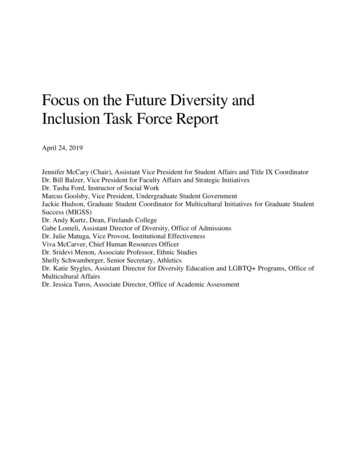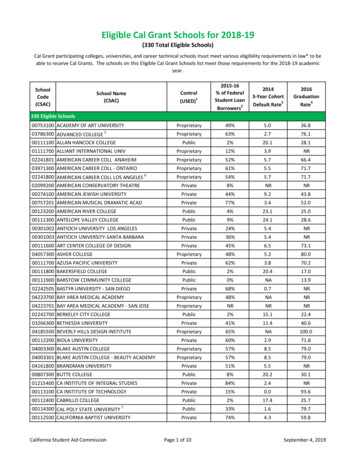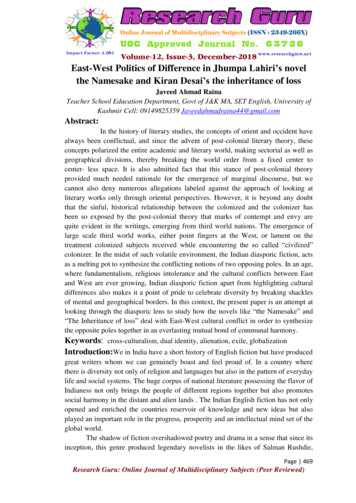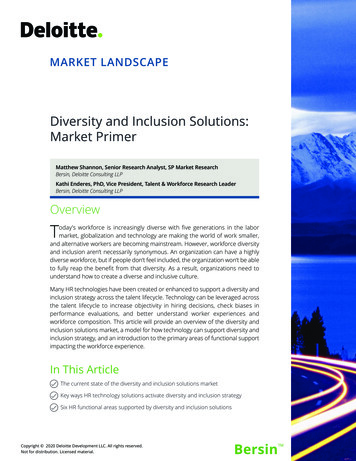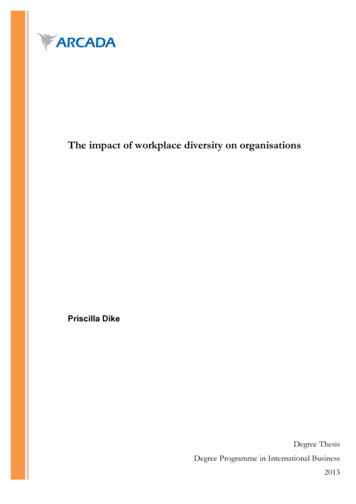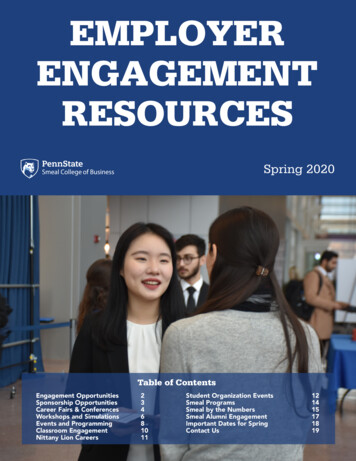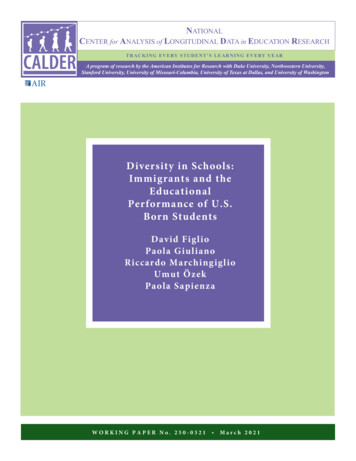
Transcription
NATIONALCENTER for ANALYSIS of LONGITUDINAL DATA in EDUCATION RESEARCHTRACKING EVERY STUDENT’S LEARNING EVERY YEARA program of research by the American Institutes for Research with Duke University, Northwestern University,Stanford University, University of Missouri-Columbia, University of Texas at Dallas, and University of WashingtonDiversity in Schools:Immigrants and theEducationalPerformance of U.S.Born StudentsDavid FiglioPaola GiulianoRiccardo MarchingiglioUmut ÖzekPaola SapienzaWORKING PAPER No. 250-0321 March 2021
Diversity in Schools: Immigrants and the EducationalPerformance of U.S. Born StudentsDavid FiglioNorthwestern UniversityNBERCALDERPaola GiulianoUCLANBERRiccardo MarchingiglioNorthwestern UniversityUmut ÖzekCALDERAmerican Institutes for ResearchPaola SapienzaNorthwestern UniversityNBER
ContentsContents . iAcknowledgments. iiAbstract . iii1.Introduction . 12.Data and Variables of Interest . 42.1 Data Sources . 42.2 Definition of Immigrants . 52.3 Measure of Immigrant Exposure. 62.4 Outcome Variables. 62.5 Individual Controls . 72.6 Definition of U.S. Born Students and Construction of the Sample of Interest . 72.7 Characteristics of Immigrants . 82.8 U.S. Born Students’ Exposure to Immigrant Students . 93.Empirical Analysis . 103.1 Main Results . 103.2 Additional Compositional and Selection Issues . 154.Heterogeneity . 175.Alternative Interpretations . 206.Conclusions . 22References . 24Figures . 27Tables . 37Appendix Tables . 51Appendix Figures . 70i
AcknowledgmentsThis research was funded by the Russell Sage Foundation. We thank Jennifer Hunt, Andrea Ichino,Victor Lavy, Daniele Paserman, Bruce Sacerdote, Cynthia van der Werf, and participants at variousseminars and conferences for helpful comments, and Gaia Dossi for truly outstanding researchassistantship. We are especially grateful to the Florida Department of Education and Health forproviding the linked anonymous population-level administrative data that permitted this analysis to takeplace. All errors and opinions are those of the authors and do not reflect those of the funders or theFlorida Departments of Education and Health. Interested researchers may request access to Floridaadministrative data through the processes described at xternal-research-requests.CALDER working papers have not undergone final formal review and should be cited as workingpapers. They are intended to encourage discussion and suggestions for revision before final publication.Any opinions, findings, and conclusions expressed in these papers are those of the authors and do notnecessarily reflect the views of our funders.CALDER American Institutes for Research1400 Crystal Drive 10th Floor, Arlington, VA 22202202-403-5796 www.caldercenter.orgii
Diversity in Schools: Immigrants and the Educational Performance of U.S. Born StudentsDavid Figlio, Paola Giuliano, Riccardo Marchingiglio, Umut Özek, Paola SapienzaCALDER Working Paper No. 250-0321March 2021AbstractWe study the effect of exposure to immigrants on the educational outcomes of US-born students, using aunique dataset combining population-level birth and school records from Florida. This research questionis complicated by substantial school selection of US-born students, especially among White andcomparatively affluent students, in response to the presence of immigrant students in the school. Wepropose a new identification strategy to partial out the unobserved non-random selection into schools,and find that the presence of immigrant students has a positive effect on the academic achievement ofUS-born students, especially for students from disadvantaged backgrounds. Moreover, the presence ofimmigrants does not affect negatively the performance of affluent US-born students, who typically showa higher academic achievement compared to immigrant students. We provide suggestive evidence onpotential channels.iii
1. IntroductionOver the past 50 years, immigration rates into the United States have risen dramatically. As aresult, almost one out of four (23 percent) public school students in the United States came from animmigrant household in 2015 (either foreign-born students or second generation students), withconcentrations over 70% in several school districts (and even higher in some communities, includingas high as 93 percent in northeast Miami-Dade County, Florida, 91 percent in Jackson Heights andNorth Corona, New York, and 85 percent in Westpark Tollway, Texas). These trends have generateda policy debate about the effects of immigration on public education and the perceived costs thatimmigrants may impose on public schools, local governments, and educational outcomes of the USborn student population.Given the sheer size of immigrants in US schools and their unique cultural backgrounds,studying their impact on US-born students is of first order importance. On one hand, immigrants mayface challenges in assimilation that may require additional school resources which could be taken awayfrom US-born students (Fix and Zimmerman, 1993). On the other hand, especially some groups ofimmigrants, through hard work and resilience, outperform non-immigrant students with similar socioeconomic backgrounds (Hsin and Xie, 2014) and can positively affect exposed US-born students’attitudes and behavior (Hunt, 2016). Yet, the academic research about the impact of immigrantstudents on the educational performance of US-born students is limited 2, especially compared to theliterature about the effect of immigrants on labor market outcomes 3, primarily due to two importantempirical challenges.First, immigrant students are not randomly assigned to schools, and are more likely to enrollin schools educating students from disadvantaged backgrounds (e.g., Card 2001; Figlio and OzekThere are a few studies that examine the effects of immigrant students on US-born student outcomes. Forexample, Schwartz and Stiefel (2011) use within-school variation and find a negative effect of immigrant shareon the performance of US-born students in New York City public schools. McHenry (2015) and Hunt (2016)examine the effects on high school completion rates of native-born students and find positive immigranteffects, especially among students from disadvantaged backgrounds. Similarly, Neymotin (2009) finds noadverse effect of immigration on the SAT-scores and college application patterns of US-born students. Thereare also studies in the US context that investigate the effects of specific immigrant groups (e.g., refugees) onUS-born student outcomes (Figlio and Ozek, 2019; Morales 2020; Ozek, forthcoming; Van der Werf 2021).3 The results on the labor market effects of immigrants are mixed. Friedberg and Hunt (1995) and Card (2001)find that immigration has a small negative effect on employment rates and wages of low-skilled native-bornworkers, whereas Borjas (2003) finds a larger negative impact on the wages of low-skilled native-born workers,particularly those without high school diplomas. Ottaviano and Peri (2012) argue that the small negative impactof immigration on low-skilled native-born wages and employment is outweighed by increased demand forhigher-level workers and improved physical capital.21
2019). Second, US-born students, especially those from comparatively affluent families, may decide toleave when a large share of immigrant students move into their school district. Indeed, evidence showsthat in the US, following an influx of disadvantaged students and immigrants, affluent, especiallyWhite, students move to private schools or districts with higher socio-economic status (SES) families,a phenomenon which has been labeled “white flight” (Betts and Fairlie, 2003; Cascio and Lewis, 2012;Fairlie and Resch, 2002; Li, 2009). Both of these factors imply that immigrant exposure is negativelycorrelated with the SES of US-born students. Therefore, research that does not address the nonrandom selection of US-born students is likely to estimate a correlation between immigrant exposureand US-born student outcomes that is more negative than the true relationship. The unique featuresof our data allow us to directly address both selection issues for the US. 4We study the effects of exposure to immigrants on the educational outcomes of US-bornstudents using unique administrative data from Florida that link population-level school records andbirth records. There are several advantages in using this dataset. First, birth records allow us to identifysiblings and control for all the observable and unobservable family characteristics (even family life-cyclecharacteristics) with the inclusion of family-year fixed effects. Second, the dataset follows individualstudents over time, thus allowing us to measure a cumulative exposure to immigrants. Using thisinformation, our first identification strategy compares test scores in math and reading of siblings whoexperience different cumulative exposures to school-cohort-specific immigrant concentrations,holding the heterogeneity in family life-cycle fixed. Further, because we have information on the entirepopulation of students attending public schools during this period, we can employ a secondidentification strategy to address the possibility that families select schools differentially for each childusing an instrumental variable approach. Specifically, we build a measure of predicted immigrantexposure using aggregate school-to-school transition probabilities, for each student at each subsequentgrade, starting from the first grade the student is observed. For example, two siblings who started inthe same school (in different years) will have the same predicted transition matrix but a differentpredicted exposure to immigrants, which depends on their specific cohort.Several papers have studied this topic outside the US finding zero or negative effects (Jensen and Rasmussen,2011; Brunello and Rocco, 2013; Ballatore et al., 2018; Tornello, 2016; Ohinata and van Ours 2013; Geay et al.,2013; and Schneeweis, 2015; Bossavie, 2020). Gould et al. (2009) successfully addressed the selection ofimmigrants into schools by exploiting an exogenous inflow of refugees from the Soviet Union that occurred inIsrael during the 1990s. They find a negative effect of immigration on the probability of passing the high-schoolmatriculation exam, affecting mostly poor Israelis.42
Our empirical analysis proceeds in several steps. We first calculate a measure of cumulativeimmigrant exposure using the longitudinal aspect of our data. We then estimate a specification similarto the one commonly used in the extant literature in order to address the first form of nonrandomselection described above. This specification compares students with different exposures toimmigrants, only controlling for school and grade fixed effects (both interacted with calendar yeardummies). When we run this regression, we find a significant--although small in magnitude--negativecorrelation between the share of immigrants and the natives’ scholastic performance in bothmathematics and reading. But this specification does not address the non-random selection of USborn students based on the expected immigrant concentration of the school. We therefore comparesiblings’ outcomes with the inclusion of family fixed effects. When we employ this specification, theestimated relationship between immigrant concentration and student outcomes becomes positive.This fundamental finding is unaffected by still more stringent identification strategies, such asincluding family-year fixed effects to control for family lifecycle changes, or instrumental variableapproaches. The reason for the discrepancy between our findings and those that do not addressnonrandom US-born student selection into schools is that there is strong evidence that US-bornstudents indeed sort into schools on the basis of immigrant concentration. This sorting is concentratedamong White and affluent students, consistent with the white flight literature (Betts and Fairlie, 2003;Cascio and Lewis, 2012). By contrast, our evidence suggests that, on average, Black and lower-SESstudents do not move away from schools or districts with a larger fraction of immigrants.For the overall sample, the magnitude of the results indicates that moving from the tenth tothe 90th percentile in the distribution of cumulative exposure to foreign-born students (1% and 13%,respectively) increases the score in mathematics and reading by 2.7% and 1.7% of a standard deviation,respectively. This effect corresponds to 8.5% of the differences in scores between children whosemother has a high school diploma and children whose mother has not completed high school. Wealso find that this effect is twice as large for free-or-reduced-priced lunch (FRPL) eligible students andfor Black students.These heterogeneous effects hint at the possibility that US-born students with differentdemographics are exposed to immigrant students with different levels of academic performance.Indeed, we find that immigrants who go to schools with higher shares of Black or FRPL eligiblestudents underperform immigrants who go to school with higher shares of White or FRPL ineligibleUS-born students. On the other hand, immigrants going to high-Black or high-poverty schoolsoutperform US-born students in the same school-year-grade, while White and FRPL ineligible US3
born students, on average, outperform foreign-born students in the same school-year-grade. We alsofind that immigrants have fewer disciplinary incidents than US-born students, but the difference inbehavior is mostly observed in schools where the majority of US-born are disadvantaged students.If academic achievement and behavior matter to explain the positive effect of immigrantexposure, one should expect that the higher the fraction of high performing and “better behaved”immigrants, the more positive the impact on US-born students. The reflection problem (Manski, 1993)and endogeneity issues do not allow the identification of the causal impact of the achievement ofimmigrants on the performance of US-born students. Instead of including actual immigrantperformance in the regression, we calculate a proxy for expected performance, by using the averageimmigrant academic performance and/or disciplinary behavior by country of origin and multiply it bythe fraction of immigrants in each grade/school/year. This measure of immigrant exposure weightedby country of origin average performance proxies for the potential academic achievement (andbehavior) of immigrants. We show that the presence of immigrants with higher expected academicperformance correlates with better scores of US-born students in the overall sample and across everysubsample. After controlling for expected academic achievement of the immigrants, the coefficienton the immigrant exposure variable remains similar to our baseline specification.It is also possible that what matters is not just the absolute performance of the immigrants,but how much better or worse they perform vis-à-vis US-born students in the same school-gradeyear. We cannot test this hypothesis directly because we do not observe the potential performance ofeach US-born student in absence of their exposure to immigrants. Nonetheless, we find suggestiveevidence that the effect on US-born students is larger when the immigrants systematically outperformUS-born students. Overall, these results suggest that immigrant students do not affect negatively USborn students, even when the immigrants’ academic achievement is lower than the US-born students,and may have a positive impact on US-born students when immigrants outperform them.2. Data and Variables of Interest2.1Data SourcesWe use a unique dataset of school records for the state of Florida, maintained by the FloridaDepartment of Education (FLDOE), merged with birth vital records from the Florida Bureau of VitalStatistics. The individual-level administrative data from the FLDOE contain information on K-12students who attended Florida public schools between 2002-2003 and 2011-2012. The data containfor each child the results of the Florida Comprehensive Assessment Test (FCAT) in reading and4
mathematics administered annually to all students in grades 3 through 10, as well as disciplinaryincidents. The dataset also contains information about the country of origin of the child and thelanguage spoken at home. Birth vital records contain a larger set of SES measures for children bornin Florida (such as maternal education, marital status, and age of the mother when the child was born),normally not included in school records. 5 The match with birth certificates allows us to identifychildren belonging to the same family and to exploit within family variation. Since data from birthcertificates are available only for children born in Florida between 1994 and 2002, we limit our analysisto these cohorts.2.2Definition of ImmigrantsOur goal is to study the effect of immigrant exposure on the performance of US-bornstudents. We define as immigrants all students born in a foreign country (the information on the countryof origin is in the school administrative records). Therefore, given our definition, immigrant isequivalent to foreign-born. 6 Because we do not have birth certificates for Puerto Rican students, we areunable to include them in the sample of US-born students. Therefore, the best way to treat PuertoRicans in this analysis is not obvious: we can either include them with the foreign students to calculatethe foreign exposure measure or we can exclude them altogether from the analysis. We adopt bothstrategies. In the baseline regression, we treat Puerto Ricans as “immigrants” on the ground that theyare culturally distinct from many other US citizens. However, in a robustness analysis, we do notinclude them in the construction of the immigrant exposure variable and the results are unchangedfrom the baseline. We therefore conclude that our choice of treatment of Puerto Rican-born studentsas “immigrants” does not influence our findings.The birth certificates provide information on whether the mother was born abroad. Thus, wecould have added to the first generation immigrants children born in the US with parents born abroadBirth certificates and school records were matched using first and last names, date of birth and social securitynumbers. The sample of birth records consists of 2,047,633 observations. Of these, 1,652,333 were present inFlorida public school data. The match rate of 81% is consistent with the percentage of children who are bornin Florida, reside there until school age, and attend public school, as calculated from the Census and theAmerican Community survey for the corresponding years. See Figlio et al. (2014) for details about the natureand additional evidence on the quality of the birth-school data merge.6One complication in our data is that some US citizens born abroad (most notably because of parents servingin the military) are recorded as “foreign-born” in the data. There is no perfect way to address this limitation,but we can at least try to partially bound the effect by excluding observations from the four Florida counties(Bay, Brevard, Clay, and Okaloosa) with large military concentrations to gauge whether our results are sensitiveto their inclusion; results remain highly consistent regardless of whether we include or exclude these militaryintensive counties (at request by the authors).55
(second generation immigrants). Because we do not have information on the immigrant status of thefather we do not follow this strategy.2.3Measure of Immigrant ExposureWe adopt a cumulative measure of immigrant exposure, in which we aggregate the share offoreign-born students to whom a US-born student has been exposed from kindergarten to the timeof observation (measured at the school-grade-year cell level.) This is the most flexible approach tostudying exposure because it does not require us to take a stand regarding the degree to which theeffects of immigrant exposure persist beyond contemporaneous exposure. Several papers in theeducation literature have argued that the effects of time-varying inputs (schooling-related as well aschild- and family-related) may decay over time rather than only be observed contemporaneously(Clotfelter et al., 2006; Clotfelter et al., 2007; Todd and Wolpin, 2003; Rothstein, 2010). Therefore, weconsider a general model of immigrant exposure using a geometric specification with different ratesof decay, where λ represents the decay factor. For each student i in school s, current grade g andacademic year t, the measure of cumulative exposure (weighted by distance in time from the currentobservation) is calculated using the following formula:𝐸𝐸𝑖𝑖𝑠𝑠𝑠𝑠𝑠𝑠 𝑔𝑔′ 𝑔𝑔 ��𝐼𝐼𝐼𝐼𝐼 ��𝑖𝑖𝑖′𝑡𝑡 𝑒𝑒 1 𝜆𝜆 𝑔𝑔 𝑔𝑔′ 𝑔𝑔′ 𝑔𝑔 𝑒𝑒 1 𝜆𝜆 (𝑔𝑔 𝑔𝑔′) (1)where ��𝐼𝐼𝐼𝐼𝐼 � is the exposure in grade 𝑔𝑔′.The literature does not provide a direction on the specific size of 𝜆𝜆: the previous literature hasproduced some estimates regarding decay in teachers’ effect, but nothing specific regarding the effectof peer students. This specification permits a wide range of models, from a model in which last year’sexposure is just as influential as contemporaneous exposure (𝜆𝜆 0) to a model in which onlycontemporaneous exposure matters (𝜆𝜆 increasing to infinity). In our baseline, we begin with a zerodecay model (𝜆𝜆 0) and later we expand it to include different 𝜆𝜆s. Thus, our baseline definition ofcumulative exposure for each student i in school s, grade g and academic year t, 𝐼𝐼𝐼𝐼𝐼𝐼𝐼 ��𝐸𝑒𝑒𝑖𝑖𝑖𝑖𝑖𝑖𝑖𝑖 Outcome Variables1 ��𝐼𝐼𝐼𝐼𝐼 ��𝑖𝑖𝑖′𝑡𝑡𝑔𝑔 ′𝑔𝑔 𝑔𝑔(2)Our main outcomes of interest are Florida Comprehensive Assessment Test (FCAT) scoresin mathematics and reading from grade 3 to grade 10 (the first and last year of statewide testing).6
Because Florida transitioned to a new version of the test, called FCAT 2.0, in 2011 and to aid ininterpretation, we standardize the statewide test scores to zero mean and unit variance at thegrade/year level over the entire population of students.2.5Individual ControlsIn our specification, we include as controls several demographic variables (age in months,gender, birth order fixed effects, and race dummies), a measure of low-income status (a dummy forwhether the student is eligible to receive free-or-reduced-priced lunch or attend a “provision 2”school, where such a large fraction of students are eligible that individual documentation is notcollected, as almost all students are presumptively eligible), a measure for whether the student receivesspecial education services, and dummies for maternal education (high school graduate, some collegeand four years of college or more, with the excluded group given by mothers who dropped out ofhigh school). 72.6Definition of US-born Students and Construction of the Sample of InterestWe define as US-born students all students born in the US who speak English at home. Giventhe large fraction of second generation immigrant students, we believe that the language restriction ismore likely to select students who fully identify as Americans. However, in robustness analysis weremove this language restriction. In the Florida Department of Education data, we have the fullpopulation of students going to Florida public schools during the period 2002-2012. 8 Given ouridentification strategy, in our analysis we select the sample for which (1) we have test scores and (2)The race/ethnicity variables are collected by Florida Department of Education according to the followingcategories: Hispanic/Latino of any race (Hispanic for brevity), American Indian or Alaska Native (classifiedinto “Others”), Asian, Black or African American (Black for brevity), Native Hawaiian or Other Pacific Islander(classified into “Others”), White, Two or more races (classified into “Others”). FLDOE forces a choicebetween White, Black, or Hispanic, so each student chooses a single identity. To qualify for free or reducedlunch, the family income has to be respectively below 185% and 130% of the federal income poverty. Provision2 schools establish claiming percentages and serve all meals at no charge for a 4-year period. For details, -1-2-and-3. Categories for special education includementally handicapped, orthopedically, speech, language, or visually impaired, deaf or hard of hearing. It alsoincludes students with emotional or behavioral disabilities, with autistic spectrum disorder, and other forms ofserious disabilities (such as students with traumatic brain injuries). Maternal education data are reported in birthvital records.8 In Table A2 of the On-line Appendix, we report the descriptive statistics of the US-born students going toprivate and public schools in Florida. Using Census 2000 data, we compare the population of immigrantstudents attending public schools in Florida (93%) with those of the US-born (88%). US-born students, onaverage, are exposed to immigrant children who have lower SES than themselves, independently from theschool setting: the family income of US-born students going to private (public) schools is 102,409 ( 55,838),while the income of immigrant students going to private (public) schools is 86,163 ( 43,526). The patterns aresimilar for 2010.77
we can link school records to birth certificates. We report descriptive statistics for this sample inColumns 1 to 3 of Table A1.A, in the Appendix. This sample contains 8,010,198 (7,490,949)observations for reading (math) scores. 9 The US-born students with a birth certificate in the FloridaDepartment of Education data are slightly positively selected compared to all students attendingFlorida public schools (standardized math and reading scores are 0.044 and 0.052). As our mostdemanding specification makes use of family-year fixed effects, we further restrict this sample tostudent-year observations in families with at least two children in the Florida public school system ina given academic year. This sample consists of 1,789,450 student-year observations (columns 4 to 6,Table A1.A). When we restrict the sample to US-born students speaking English at home (TableA1.A), we obtain 6,341,333 observations (columns 7 to 9). From this sample, restricting toobservations in families with at least two children in school in a given academic year leads to 1,450,139observations for reading scores and 1,347,287 for math scores (Columns 10 to 12 of Table A1.A).Our final sample has similar standardized test scores to the original sample with birth certificates: 0.05for math and 0.034 for reading.2.7Characteristics of ImmigrantsColumns 1 to 3 of Table A1.B report the sample statistics for the immigrant students who goto school with the sample of U.S. born students described in Columns 1 to 3 of Table A1.A. Immigrantstudents’ performance in math (-0.097) and reading (-0.206) is lower than the one of US-born
This research was funded by the Russell Sage Foundation. We thank Jennifer Hunt, Andrea Ichino, Victor Lavy, Daniele Paserman, Bruce Sacerdote, Cynthia van der Werf, and participants at various seminars and conferences for helpful comments, and



